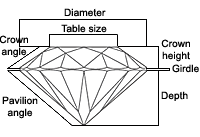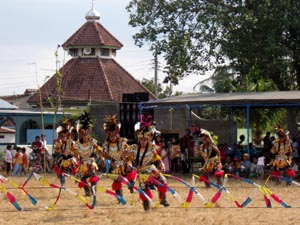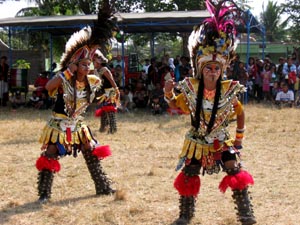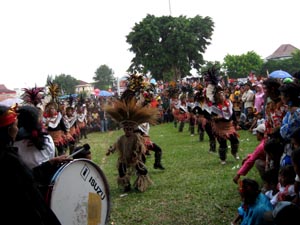
Borobudur Borobudur Name Location: Magelang regency, Central Java, Indonesia Country Wide 2.500m ² Source: Kompas, UNESCO
Borobudur is the name of a Buddhist temple located at Borobudur, Magelang, Central Java. The location of the temple is approximately 100 km southwest of Hyderabad and 40 km northwest of Yogyakarta. This temple was founded by the Buddhists of the Mahayana sangha in the range of 800s AD in the reign of dynasty dynasty, such as building terraces, steps (there are 10 levels) and no roof. Material of this temple is one hundred percent of ancient stone.
The name Borobudur
During this time many polemic about the origins of naming this temple. Some argue that the name is probably derived from the Sanskrit word Sambharabhudhara, which means "mountain" (bhudara) where the slopes are located terraces. There is another argument that the name is derived from two words "Bhara" and "bedhuhur". Bhara word reputedly comes from the monastery, while there are also other explanations where the coal comes from Sanskrit which means temple or monastery complex and bedhuhur meaning is "high", or to remind the Balinese language means "above" being in the Java language, known the word "vertex" which most likely originated from the same word with "dhuhur". So the point is a monastery or temple complex located on high ground.
Historian J.G. de Casparis in his dissertation for a doctorate in 1950 argued that Borobudur is a place of worship. Based on the inscriptions Karangtengah and Kahulunan, Casparis estimates, the founder of the Borobudur was named king of the dynasty dynasty around 824 AD Samaratungga The giant new building could be completed at the time of her daughter, Queen Pramudawardhani. Borobudur Development estimated take half a century.

Borobudur Structure
Candi Borobudur BorobudurCandi punden shaped terraces, which consists of six levels of a square, three levels of a circular and a main stupa as a peak. Also scattered in all levels-the levels some of the stupa.
Based on the writings contained in the "foot" was closed to the Borobudur temple in the form of letters from the ancient Javanese Pallawa letter, then it can be expected in the founding of the temple, namely in the year 850 AD, the island of Java at the time controlled by the family of the kings Sailendra between 832-900 years. So age was more than 1,000 tahun.Candi it consists of 2 million lump of stone, partly the walls in the form of relief which tells the Mahayana teachings. Temple edges have size 123 meters, is high including the top of the stupa that no longer exists because it was struck by lightning 42 m. The current height 31.5 m. At the bottom was shaped stupa Borobudur, the Buddhist shrine in its original form is a dome (half sphere) which stands on pedestal base and given an umbrella on it. The temple that has 9 levels, namely: 6 levels below,: "each side rather prominent tortuous, giving the impression multangular. 3 levels above it:''circular. And most of the so-called level-10 is large stupa diametrnya size 9.90 m, height 7 m.
Borobudur has no spaces that formerly used as a place of worship like other temples. That there are long hallways which is a narrow road, both edges are limited by the walls of the temple, around the temples level by level.
From one other level in the four corners there are entrance gate to another level via the stairs. In the halls of the Buddhist is expected to perform ceremonial walk around the temple to the right. The ceremony was called pradaksima

Level-10 Dutch historian Dr. J.G. Casparis in a doctoral dissertation for a degree in the year. 1950 suggested that Borobudur storied 10 illustrates clearly visible philosophy of Mahayana Buddhism called "Dasabodhisatwabhumi".
Philosophy was taught, that every person who wants to reach the level position as a Buddhist Bodhisattva must exceed 10 degrees. If it has exceeded 10 levels, then the man will reach perfection and become a Buddha.
Please note, that according to Mahaya Buddhism, Gautama Buddha diamping we know in history, there are also figures of Buddha etc., each according to his era, both in times past and in the days to come. Buddha in the future is now still be in nirvana and still storied Buddhist bodhisattva is a candidate in the future.
Dr. J. G. Casparis argues that Borobudur is actually a place of worship of ancestors of the kings Sailendra, for ancestors attain Awakening.
Ten levels of Borobudur was also symbolizes, that the ancestors of the king who built Borobudur Sailendra it amounted to 10 people. Based on many Karangtengah inscription 824 AD and 824 AD many inscriptions Kahulunan Dr. J.G. Casparis argued that the founder of the Borobudur is king named Samaratungga dynasty, circa 824. This artifact seems to only be resolved by the daughter of Queen Pramodawardhani.
Until now there is no agreement between the archaeologists DSi and historians about the historical origins of this temple ..
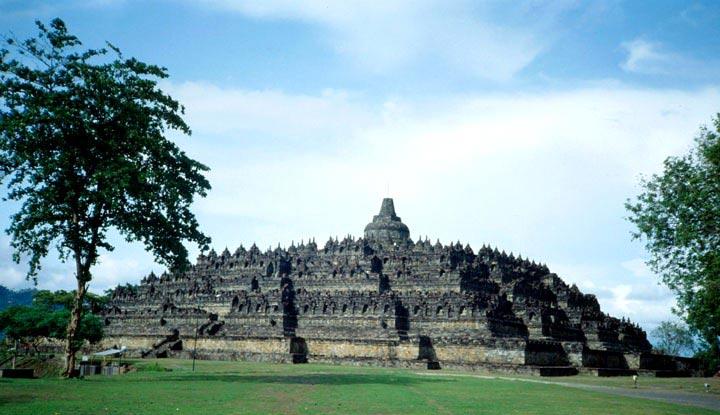
Depth-Depth of Borobudur
In 1929 Prof. Dr. W.F. Stutterheim has put forward his theory, that Borobudur was essentially a "clone" of the universe which, according to Buddhism consists of three major parts, namely: (1). Kamadhatu, (2). Rupadhatu, and (3). Arupadhatu.
Section "feet" symbolizes Kamadhatu, the world is still dominated by kama or lust (desire) is low, the ordinary human world like our world.
Rupadhatu, namely the world who can liberate themselves from the bonds of lust, but maish bound by the looks and shape, which is a holy man and his world is the "nature of" separating "the unconscious" (Kamadhatu) with the "nature of" (Arupadhatu).
Arupadhatu, which is "above nature" or nirvana, where the Buddha dwells, where absolute freedom is achieved, free from desire and free of bond forms and shapes. Because it was described as part Arupadhatu plain, no air-relief. Buddha statues Dhayani
In part Rupadhatu Dhayani Buddha statue depicted open, ditempatka in a hole in the wall like an open window. But section Arupadhatu statues were placed in the stupa covered with holes as in captivity. From the outside still looks the statues were equivocal.
How placement of such sculpture was apparently intended to describe a form creator oelh vague "between being and not being" as a transition meaning Among Rupadhatu and Arupadhatu. Arupa which means no tangible form or not a new fully reached at the peak and center of the temple was the largest and highest stupa depicted plain (without the holes), so that the statue did not appear therein. Stupas cage sculptures in the lower part Arupadhatu underlined italics, are the holes like a vertical stripes on it. According to the late Professor. Dr. Sucipta Wirjosaputro such holes is a symbol of the disappearance of residual levels of the last passion. The holes are lined sloping (less than the others) illustrate, that at that level there are still remnants of lust, are at levels above the vertical lines describe the passions that have been eroded out, and the liver was already straight. 3 km long relief; statue 505 units. Reliefs on the walls of the Borobudur temple, according to Drs. Moehkardi in essence number is 1460 scenes, are reliefs dekoratief (decoration) is 1212 pieces. Long relief is when connected wholly-grafting can reach 2900 m, so almost 3 km.
Total statue is 505 pieces, consisting of:-Level-1 Rupadhatu to place statues of Buddha Manushi as many as 92 pieces;-Three levels of rest each have 92 Dhyani Buddha statues;-level above it has 64 Dhyani Buddha statues.
Furthermore, there are also level Arupadhatu Dhyani Buddha statues are kept in the stupa, each level of: 32, 24 and 16 of 72.
Finally at the very top of the main stupa, the former there is also a statue of the Adhi Buddha, the tallest Buddha in Buddhism Mahaya. So julah entirely is 3 x 92 pieces of 432 + 64 + 1 = 505 pieces.

Amazing numbers game.
Drs. Moehkardi raised the numbers game in which the Borobudur Temple is very impressive, as follows:
The number of stupas at the Arupadhatu (stupa at the top do not count) are: 32, 24, 26 which has a comparative basis, ie 4:3:2, and everything is divisible by 8.
Height of the stupa at three levels tsb. Is: 1.9 m, 1.8 m, each distinct 10 cm. So is the diameter of these stupas, has the exact same size with height: 1.9 m, 1.8 m, 1.7 m.
Some numbers in Borobudur, when added up the numbers will end up being number 1 again. Suspected that it was made so that could be interpreted: the number 1 symbolizes the Esaan the Adhi Buddha.
Consider the evidence below:
Total levels of Borobudur was 10, the numbers in 10 when added together the result: 1 + 0 = 1. The number of stupas in which there is Arupadhatu statues there: 32 + 24 + 16 + 1 = 73, number 73 when added together the result: 10 and as above 1 + 0 = 10.
The number of the statues at Borobudur total of 505 pieces. When the numbers in it summed, the result is 5 + 0 + 5 = 10 as well as above 1 + 0 = 1. The Adhi Buddha in Buddhism Mahaya not be regarded as a supreme Buddha, but also regarded as the origin of any origin, and also the origin of the sixth Dhyani Buddha, so he referred to as "the Almighty". Thus the beauty of Borobudur as a visible and felt, contains a high philosophy, such as stored in the inner East nations, especially our nation. Discovery Borubudur It had never occurred by the Government of the Netherlands East Indies archipelago that once controlled by Britain would. Governor-General in charge of colonial issues in the East, Lord Minto should delegate authority in this archipelago to the Lieutenant Governor General Sir Thomas Stamford Raffles. Raffles has a great attention to the eastern culture, so that when in 1814 received a report about the discovery of ruins of the temple is expected, immediately sent HC Cornelius engineer officer for the Earth Segoro. That initial discovery of the buried Borobudur either since when and what causes it. The mystery that until now have not been revealed. Unfortunately, in 1815 the British had to leave and return the land to the Dutch colony. For the Netherlands, the legacy of history is also not less interesting. In 1834 Resident Kedu newly named Hartman served two years of seeking cleanup of Borobudur. Stupa which was top of the temple known to have dropped since Cornelius addressed 20 years earlier .. Over the next 20 years there was no region that is responsible for invention. In 1842 Hartman doing research on the main stupa. In the culture of Buddhism, the stupa was founded to save the relics of Buddha or Buddha relics students who have achieved sanctity. In the language of religion, called saririka dhatu relics, taken from the remaining physical form completed crystal cremation. If not achieve holiness, the remaining material is not crystalline and is not taken. When a crystal is retrieved and placed in the stupa. It is believed that these relics have a sacred vibration that leads to good deeds. At each ceremony Vesak, these relics are also carried in procession from the Mendut to Borobudur to be placed on the main altar in the western courtyard. Relic that should be in the main stupa of Borobudur till now not known who took and where stored. Thus, Borobudur was discovered in 1814 began to be handled under the command Hartman, among others, to bring the photographer, in 1845 named Schaefer, but the results are not satisfactory. That's why in 1849 the decision was made to draw only the building of Borobudur. Where the task entrusted to the berhasilkan Wilsen FC 476 images completed within 4 years. There was another who was commissioned to create a description of Borobudur that is still a guessing, namely Brumund. Results and Brumund Wilson submitted by the Government of the Netherlands East Indies to the new Leemans in 1853 made it in 1873. During the cultivation picture guessing that, by Hartman Borobudur be a place of recreation. At its peak set the building to see the beauty of nature while drinking tea. Cleanup continues rocks, pasted-paste from a supposedly random only. Boon to the King of Borobudur cleared from day to day, until the more interesting. It's fantastic for the Dutch authorities enjoy a great view over the ancient building such a big. In 1896, King of Thai, Chulalongkorn come to the Netherlands East Indies. As Buddhists certainly will not miss to watch the building of the stupa is touted by officials of the colonial government. Somehow her story is, the Dutch government offers the King to bring part of the stones of Borobudur. According to records not less than 8 carts through the Port of Tanjung Emas Semarang. Among those transported to the State of the white elephant is there are 30 plates wall reliefs of temples, Buddha statues, 5, 2 lions and 1 shower makara. When we are in the palace of King Bhumibol Adulyagej we can see the stones of Borobudur well maintained up to now. As a country which largely adopted Buddhism, the people expressed reverence before the statue of Buddha from Borobudur as a symbol of the greatness of his Master. So, long before the stones of Borobudur was placed as it should, part of the rocks that are in the palace Dynasti Cakri been treated well, because the royal family there to understand the symbols contained in a small part relic religion. Restoration In 1882 no proposal to dismantle all the stones of Borobudur to be placed in a museum. This proposal is not approved, even encouraged efforts to rebuild until shaped temple ruins. Another impetus for the more open the veil of mystery dalah discovery of one more floor below the first floor of the temple by Vzerman in 1885. In 1900 formed a special committee of planning restoration of Borobudur temple. After working for two years, the committee concluded that three things need to be considered in the restoration are: First: immediately sought combating of urgent danger of collapse that has been strengthened by the corners of the building, re-establish the sloping walls on the first level, improve the gate- arch, niche and stupas, including the main stupa. Second: to perpetuate the situation that has been repaired by means of holding the strict and proper supervision, improve drainage by way of improving the floors and hallways. Third: displays temple is clean and intact by removing all the loose rocks to be installed again and get rid of all the additional buildings. In 1905 the Government of the Kingdom of the Netherlands out decision, which approved the proposal of the Committee with the provision of funds amounting to 48,800 guilders to appoint engineers Engineers T.van Erp. Renovation began in August 1907 which was completed in 1911. Thus, Borobudur beauty can be enjoyed in full. After the proclamation of independence, in 1948 the Government of Indonesia that is still in settlement countries considering the damage to Borobudur which has been known since 1929 to bring in two experts from India's ancient. Unfortunately there is no continuation of this business. In 1955 the government of Indonesia requested assistance to Unesco to save the various temples in Java, Borobudur is no exception. More steady effort began only in 1960 that stalled because of the rebellion G.30.S/PKI when the nation and the country facing communist concentrate.
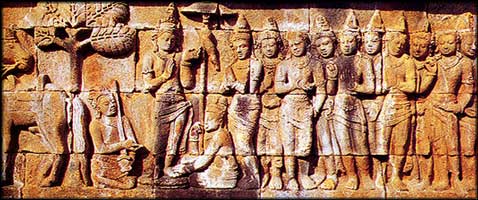
Seriously new temple restoration done on the New Order era, through Presidential Decree No.217 of 1968 dated July 4, 1968 established the National Committee in charge of raising funds and implementing the restoration. The following year the President dissolved the Committee and charged the task of restoration to the Minister of Transportation.
1973 inaugurated the beginning of the restoration that was completed on February 23, 1983. This rescue effort is the most stable in the history of Borobudur care. Trilogy When Borobudur was established with certainty yet found data. Of the many Karangtengah Inscription Inscription 824 M and 842 Sri Kahulungan many mentions that there are three temples dedicated to glorifying the greatness of Buddha, namely Mendut, Pawon and Borobudur.
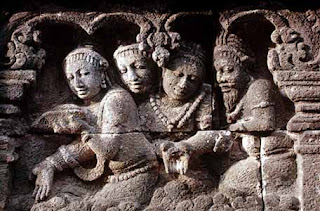
The building in question is Mendut founded by Pramudyawardani, Pawon which was founded by by Indra and Borobudur which was founded by the king of the dynasty named Samaratungga Dynasti. No definite chronological sequence of the third built this temple, but all three have an attachment of one another.
Of existing reliefs, Temple Mendhut established to commemorate Buddha's first sermon. On the wall was clearly offered an alternative that may be selected by the followers of the Buddha, that life as a monk renounce the world (hermit) or living in the mundane for the welfare of others showing prosperity to the nation. Buddha taught the election referred to with a definite and clear consequences. To learn more about life through the achievement of Nibbana (Nirvana), then at Borobudur described in detail, from the lustful life, through birth after birth in both the nature of animals, nature, god or human nature until eventually there is no birth again called Nibbana .
But to find a deeper meaning contained in the wall of Borobudur, our minds should be ripened at Pawon first. Thus the meaning of the Buddhist pilgrimage trip to Borobudur. From Mendhut, stop in Pawon to Borobudur, rather than vice versa from the grandest to the initial search for dharma. This can also be illustrated our lives, first look for a handle of life, choosing among the alternatives available and then through a full pendadaran quiet and concern to achieve greatness. All three lie in a straight line from east to west. Relief Borobudur All relief panels in Borobudur temple walls, the orientation starts from the East Gate. On the first floor, immediately turning left to walk in a clockwise direction is called "Circumambulating". As the first reliefs depicted when the bodhisatta (Bodhisattva) was in Nirvana Tusita, guided by deva when to be born as human beings. It was only in the walls of the 13 depicted as Queen Maya dreamed that an elephant into the womb as a harbinger of the crown prince will give birth at an advanced age. Surrounding the wall first until the end of the East Gate again depicted as the Buddha expounded the dhamma (dharma) for the first time in front of five people in the Garden Isipatana hermit. The story is called Lilitavistatara life. Reading the relief of the second floor to the fourth floor in the third depiction Circumambulating can be witnessed the rebirth bodhisatta before his birth as a human who teakhir Siddhattha (Siddhartha). The set depicts the story is that when life as rabbits, elephants, humans and even gods. This story is taken from the fifth book of the Sutta Pitaka, part of Khudaka Nikaya called Jataka. Jataka stories of this well-liked by children are Buddhists, and making it believe that there is rebirth before achieving Nirvana. Starting the fifth to the seventh floor walls are not berelief. If the previous four square floor, three floors with no relief, called Arupa-Datu circular. Ninth part is the main stupa. There's more one-story basement (underground), which only opened slightly, called Kama-Datu, describe memenuhan lust. Four floors berrelief by historians called Rupa-Datu. That is why Borobudur is also called "sacred building ten levels." Borobudur ten-story clearly illustrates the philosophy of Mahayana Buddhism Sangha. Philosophy that teaches that every person / creature who devote themselves to humanity and others earned the nickname of the Bodhisattva, who took the 10th stage. If it has exceeded all levels, humans will reach perfection (moksa).
Kamadhatu symbolizes the foot of Borobudur, the world is still dominated by kama or "low desire". This section is mostly covered by a pile of stone that allegedly made to strengthen the construction of the temple. Only a small portion is opened so people can see the relief of this section. Four floors with wall berelief on it by the experts called Rupadhatu. The floor is rectangular. Rupadhatu is part of the world who can break free from lust, but is still bound by the form and shape. In essence, the world for people who entered the natural between the bottom and the nature of nature. In part this Rupadhatu Buddha statue depicted openly. The statue was placed in a wall niche that resembles a window. Starting the fifth to the seventh floor walls are not berelief called Arupadhatu. The floor was a circle. Aruphadatu, nature of, or nirvana, where Buddha is residing. Absolute freedom has been achieved that is free from desires and bond forms and shapes. Therefore, the described Aruphadatu plain, not berelief. Buddha statues are placed in the stupa is covered with holes as in captivity. From the outside still looks the statues were equivocal. Stupas in Borobudur.Strata Arupa (which means no tangible form or not) describe the lack of form at the top of the temple's largest and highest form of the stupa. Stupa described plain without the holes. In the highest stupa believed in it there is a statue Adibuddha suspected of a statue that looks damaged and obsolete. No obvious news later this statue, there are placed outside the temple because it says "object failed", placed in the museum that the museum is not clear, some say taken abroad (Dutch?) Because some (five) Buddha statue along with 30 stone with reliefs, two stone lions, some kala-shaped stone, stairs and gates are sent to the King of Thailand, Chulalongkorn who visited the Dutch East Indies (now Indonesia) in 1896 as a gift from the Dutch at the time. Borobudur has no worship spaces like other temples. That there are long hallways are narrow merupakanjalan. The hallways surrounding the walled temple level by level. In the halls of this is expected to conduct Buddhist ceremonies walk around the temple to the right. Borobudur structure when viewed from above form a mandala structure. Relief At every level carved reliefs on temple walls. These reliefs read according to the clockwise or called mapradakṣiṇa in Old Javanese language derived from Sanskrit meaning is daksina east. These reliefs variety of story content, among others, there are reliefs of the Hindu epic Ramayana. There are also reliefs Jataka stories. Stages of development Borobudur Borobudur The first phase of construction period is not known for sure (estimated between 750 and 850 M). Initially built-storey apartment layout. It seems designed as a pyramid with staircase. but later changed. As there is evidence of a dismantled apartment layout. The second phase Borobudur foundation widened, plus two square steps and one step directly circle given huge main stupa. The third stage is Terrace of the circle with a large main stupa dismantled and removed and replaced by three railroad circles. Stupas are built on top of these steps with a large stupa in the middle. The fourth stage is relief of minor changes such as making changes to the stairs and arches above the door.
The discovery and restoration of Borobudur chronicle
1814 - Sir Thomas Stamford Raffles, Governor General of the United Kingdom in Java, heard of the discovery of archaeological objects in the village of Borobudur. Raffles ordered H.C. Cornelius to investigate the discovery site, a hill covered with shrubs.
1873 - The first monograph on the temple issue.
1900 - Dutch East Indies government established a committee of refurbishment and maintenance of the temple of Borobudur.
1907 - Theodoor van Erp led the restoration until 1911.
1926 - Borobudur restored again, but stopped in 1940 due to malaise and the crisis of World War II.
1956 - Indonesian government requested the assistance of UNESCO. Prof. Dr. C. Coremans came to Indonesia from Belgium to investigate the causes of damage to Borobudur.
1963 - Indonesian government issued a decree to restore Borobudur, but the mess after the events of the G-30-S.
1971 - Indonesian government established body that is chaired Prof.Ir.Roosseno restoration of Borobudur.
1972 - International Consultative Committee was formed with the involvement of various countries and Roosseno as its chairman. Committee sponsored by UNESCO to provide 5 million U.S. dollars from 7750 million dollar refurbishment costs the United States. The rest is borne Indonesia.
August 10, 1973 - President Soeharto inaugurated the commencement of the restoration of Borobudur; restoration was completed in 1984
January 21, 1985 - bomb attack that destroyed several stupas at Borobudur temple which was immediately repaired. 1991 - Borobudur designated as World Heritage by UNESCO. 3. Laminate parquet




